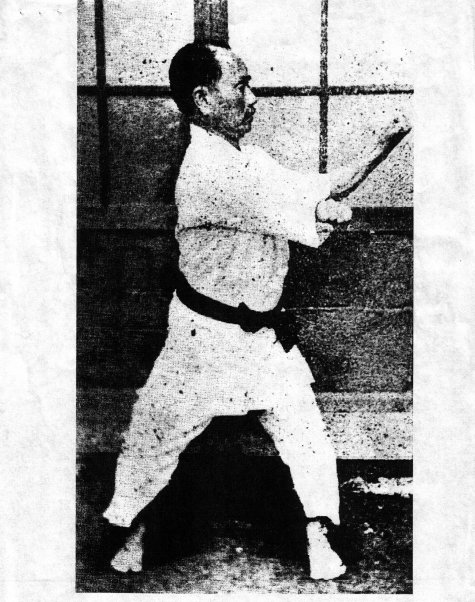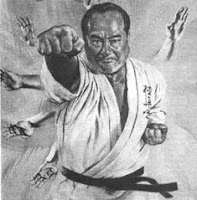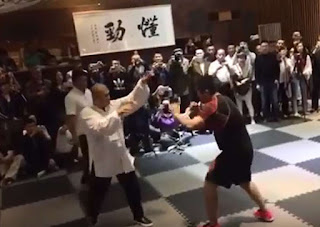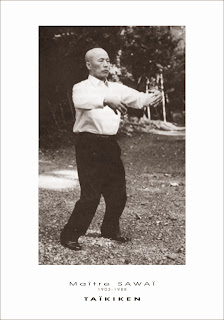Naifunchin/naihanchi and goju-ryu
 We have always taught the kata we call naifunchin (naihanchi shodan) along with the goju kata (we teach naifunchin just after saifa). Even so it is not an especially popular kata because it is so different. It really has nothing in common with the other kata (no goju kata uses kiba dachi - a horse stance where both feet point forward - but instead the kata use shiko dachi where the feet point outwards at 45 degrees). Some “shorin” schools practice naifunchin with shiko dachi and not kiba dachi - eg. Tomari te, however this might be due to the influence of Naha‑te, rather than reflecting its original form.
We have always taught the kata we call naifunchin (naihanchi shodan) along with the goju kata (we teach naifunchin just after saifa). Even so it is not an especially popular kata because it is so different. It really has nothing in common with the other kata (no goju kata uses kiba dachi - a horse stance where both feet point forward - but instead the kata use shiko dachi where the feet point outwards at 45 degrees). Some “shorin” schools practice naifunchin with shiko dachi and not kiba dachi - eg. Tomari te, however this might be due to the influence of Naha‑te, rather than reflecting its original form.Despite its somewhat "strange" feeling and uniqueness, we find that it is a very useful "conditioning" kata (heishugata) and would not consider dropping it from the syllabus. But I’ve often wondered why we, as a goju-based school, should have adopted this kata.
The simple answer has always been that our instructors originally studied Kyokushinkai, then Shotokan in Japan in the 60s. Both schools practise naifunchin in a manner similar to what we do today (Mas Oyama studied his “naifanchin” directly from Gichin Funakoshi). But why did we retain this kata when we converted to goju-ryu in the late 60s? And why not naihanchin nidan and sandan – or indeed any other shorin karate form?
There appears to be some precedent for the study of naifunchin (shodan, of course) in goju schools. I keep reading references to Miyagi and naihanchi. The most recent I recall is an interview with Anthony Mirakian in Meibukan Magazine No. 4. In that interview Mirakian refers to Chojun Miyagi teaching naifanchi, and that in the 50’s he trained naifanchi with Meitoku Yagi.
I recall Russ Smith saying somewhere that naifanchi had been practised in the Seiko Higa dojo by some of the seniors.
A more primary historical source is of course the 1936 meeting of Okinawan karate masters where Miyagi was quoted as listing “sanchin, tensho and naifanchi” as fundamental kata (see Sanizoo’s translation of the minutes). However I don’t think Miyagi’s comment can necessarily be taken to mean that he taught naifanchi (at least as a formal part of his syllabus) any more than Chiban Choshin can be taken to have taught tensho. Instead Miyagi seems to have been talking about a systematic method of teaching where the teaching of fundamental kata (heishugata) should precede other kata (kaishugata).
 What is clear from the 1936 meeting is that naifunchin is/was to the "shorin" systems what sanchin is/was to the Naha-te systems (eg. goju, ryuei ryu and uechi ryu) — a fundamental kata. It also seems likely that each of the masters were aware of, and could probably perform, each other’s fundamental kata.
What is clear from the 1936 meeting is that naifunchin is/was to the "shorin" systems what sanchin is/was to the Naha-te systems (eg. goju, ryuei ryu and uechi ryu) — a fundamental kata. It also seems likely that each of the masters were aware of, and could probably perform, each other’s fundamental kata.So why was naifunchin never formally part of the goju curriculum? I'm guessing, but it might have felt incompatible in its techniques and emphasis with the Naha-te kata. However my guess is also that naifunchin was nonetheless practised (at least occasionally) by Miyagi and his students. This in turn reflected earlier times: when the Okinawans studied just “karate” and not a style of karate; when they felt free to combine kata from different teachers (and even modify them), perhaps in the subconscious realisation that each teacher, and each student, ultimately had his (or her) own “style”.
With the 20th century influence of Japanese martial schools and their strict technical “hereditary” traditions this devolved to “borrowing” only the fundamental kata of another’s school. By the 1960s when my instructors went to Japan and Okinawa even this pared-back tradition was kept alive by relatively few.
Copyright © 2008 Dejan Djurdjevic



The style of Goju Ryu I learned also teaches Naifaunchi and Chisaukun. Peter Urban studied with Mas Oyama while he was still officially teaching Goju Ryu, which is why the style I learned also includes Naifaunchi, Hangetsu, and Wanshu.
ReplyDelete